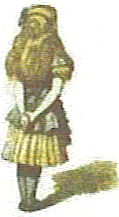Commerce is of trivial import; love, faith, truth of character, the aspiration of man, these are sacred.Ralph Waldo Emerson
I just happen to visit Cosmic Variance yesterday after not visiting for some time. The timing seemed appropriate to my questions about our histories, not only from a detailed research perspective, but from a personal one as well in terms of our memories. I do not care who is an atheist or not. Why should I apply a stereotype to another person and dictate the way the conversation can go?:)
Sean Carroll has a interesting set of four entires about the backwardness of the arrow of time and how it would appear. This is an interesting exercise for me on how perception about the current direction of the universe could have represented "the Egg before the chicken" scenarios.
Incompatible Arrows, I: Martin Amis
Incompatible Arrows, II: Kurt Vonnegut
Incompatible Arrows, III: Lewis Carroll
Incompatible Arrows, IV: F. Scott Fitzgerald
Chicken or Egg
 Illustration from Tacuina sanitatis, Fourteenth century
Illustration from Tacuina sanitatis, Fourteenth centuryReverse chronology — narrating a story, or parts of one, backwards in time — is a venerable technique in literature, going back at least as far as Virgil’s Aeneid. Much more interesting is a story with incompatible arrows of time: some characters live “backwards” while others experience life normally.
There are reasons why I find this fascinating and why the topic of Kurt Godel was introduced in that comment section. It is something that caught my eye while researching Kurt Godel. I will try and find this point and put it here for consideration. While considering the version I saw of his authored biographical comment, it made me think of the views people "can have" about the nonsensical. The feelings they can have about the "incompleteness of this life" and the succession of our views on this life as a "metamathematical position." Where is that? Some "OverSoul" perhaps?:)
It reminded me about the perspective we can have "from the here and now."
Mind Body problem
Proud atheists
Steve Paulson:I know neither of you believes in paranormal experiences like telepathy or clairvoyant dreams or contact with the dead. But hypothetically, suppose even one of these experiences were proven beyond a doubt to be real. Would the materialist position on the mind-brain question collapse in a single stroke?
PINKER: Yeah.
GOLDSTEIN: Yeah, if there was no other explanation. We'd need to have such clear evidence. I have to tell you, I've had some uncanny experiences. Once, in fact, I had a very strange experience where I seemed to be getting information from a dead person. I racked my brain trying to figure out how this could be happening. I did come up with an explanation for how I could reason this away. But it was a very powerful experience. If it could truly be demonstrated that there was more to a human being than the physical body, this would have tremendous implications.
While I had read your link Phil on Goldstein, I am not an atheist(I try and refrain from groupings) in any form, and, like the topics of "Intelligent design" or the Anthropic principle, this has no bearing on how I want to move and think in the world. I am convinced, as Goldstein was, on what is consider "proof of the afterlife" that I do not need to be reminded of what is evidenced to the contrary, until it is proofed conclusively.
"Death, so called, is but older matter dressed
In some new form. And in a varied vest,
From tenement to tenement though tossed,
The soul is still the same, the figure only lost."Poem on Pythagoras, Dryden's Ovid.
I may share a trait of Plato eh?:)Emerson? Benjamin Franklin?
From A Defense of an Essay of Dramatic Poesy (1668) by John Dryden
Imagination in a man, or reasonable creature, is supposed to participate of reason, and when that governs, as it does in the belief of fiction, reason is not destroyed, but misled, or blinded: that can prescribe tot he reason, during the time of the representation, somewhat like a weak belief of what it sees and hears; and reason suffers itself to be so hoodwinked, that it may better enjoy the pleasures of the fiction: but it is never so wholly made a captive as to be drawn headlong into a persuasion of those things which are most remote from probability: 'tis in that case a free-born subject, not a slave; it will contribute willingly its assent, as far as it sees convenient, but will not be forced....Fancy and reason go hand in hand; the first cannot leave the last behind; and though fancy, when it sees the wide gulf, would venture over, as the nimbler; yet it is withheld by reason, which will refuse to take the leap, when the distance over it appears too large
See:
The Universal Library
























